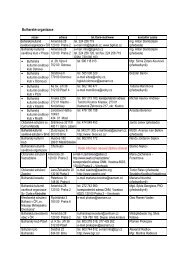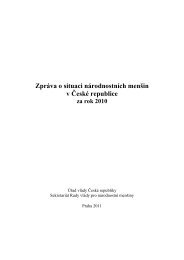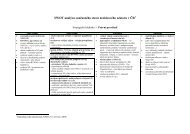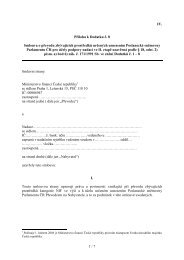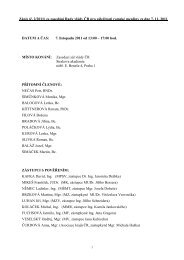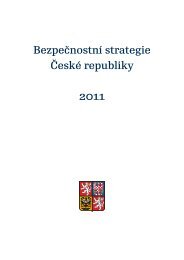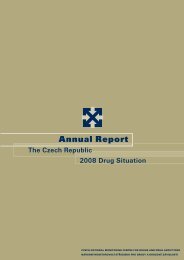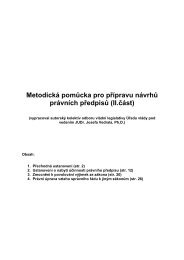The Czech Republic Annual Report 2010 Drug ... - Drogy-info.cz
The Czech Republic Annual Report 2010 Drug ... - Drogy-info.cz
The Czech Republic Annual Report 2010 Drug ... - Drogy-info.cz
You also want an ePaper? Increase the reach of your titles
YUMPU automatically turns print PDFs into web optimized ePapers that Google loves.
37% of the clients in the second (voluntary) group; these results confirmed the assumption that voluntary consent to<br />
testing was more likely in clients who can manage their drug problems better or who are more motivated to abstain<br />
from drugs. <strong>The</strong> drugs most commonly detected with the saliva tests included pervitin (56 clients), THC (21), and a<br />
combination of pervitin and THC (9). 12 confirmation tests were conducted upon a client’s request and the results of<br />
the saliva tests were not confirmed in 7 cases. Despite the limitations of the saliva tests, the probation officers<br />
considered the tests a useful monitoring instrument and generally agreed that testing built up mutual trust between<br />
the client and the officer, which, in turn, improves the willingness of the clients to discuss their drug problem and<br />
address it together with their probation officer. <strong>The</strong> PMS staff also emphasised the fact that the tests offered a more<br />
objective assessment of the client’s level of risk regarding drug use. <strong>The</strong> staff implementing the project have<br />
proposed the introduction of drug testing as a standard monitoring instrument of the Probation and Mediation<br />
Service.<br />
According to the PMS (Probační a mediační služba ČR, <strong>2010</strong>a), in <strong>2010</strong> there were a total of 3 probation<br />
programmes accredited by the Ministry of Justice that aimed at minors aged 15–18 and focused, among other risk<br />
forms of behaviour, on drug-related problems. <strong>The</strong>y were the Proboš programme, carried out by the Renarkon public<br />
service company in Frýdek-Místek, the Auritus programme, carried out by the Tábor Parish Charity, specifically its<br />
Auritus centre for people at risk from drugs, and the MOST programme, implemented by the Třebíč branch of the<br />
Brno Diocesan Charity. <strong>The</strong>se programmes offered <strong>info</strong>rmation services, individual counselling, motivational training,<br />
and crisis intervention to minors at risk of the use of drugs, especially marijuana.<br />
9.2 Prevention of <strong>Drug</strong>-Related Crime<br />
In the <strong>Czech</strong> <strong>Republic</strong>, crime prevention is within the competence of the Ministry of the Interior 115 , which also<br />
prepares the 2008–2011 Crime Prevention Strategy; for details see the 2009 <strong>Annual</strong> <strong>Report</strong>. <strong>The</strong> issue of crime<br />
prevention also falls within the competence of the Ministry of Education, which is in charge of the prevention of risk<br />
behaviour among children and young people; for details see the chapter on Prevention (p. 41).<br />
<strong>The</strong> specific activities pertaining to the prevention of drug-related crime were mainly conducted by the National <strong>Drug</strong><br />
Headquarters in <strong>2010</strong>. Carried out by the National <strong>Drug</strong> Headquarters in cooperation with the <strong>Czech</strong> Chamber of<br />
Pharmacists since 2009, the project named I Do Not Support <strong>Drug</strong> Production aims at preventing the sales of larger<br />
quantities of medicinal products containing pseudoephedrine to persons reasonably suspected of being involved in<br />
pervitin production. In connection with the detection of illegal large-scale cannabis plantations, in 2009 the National<br />
<strong>Drug</strong> Headquarters also started to cooperate with the representatives of power distribution companies, which can be<br />
the first to raise a suspicion of indoor cannabis cultivation on the basis of abnormally high power consumption by a<br />
single distribution point or significant losses on the grid in a particular location. <strong>The</strong> evaluation of the effectiveness of<br />
the two above-mentioned projects is not available.<br />
9.3 Interventions in the Criminal Justice System<br />
Even though compulsory treatment and security detention (protective measures) may be included among penalties<br />
under criminal law, their nature is rather preventative and they do not express the condemnation of the perpetrators<br />
and the level of their guilt; for more details see the 2008 and 2009 <strong>Annual</strong> <strong>Report</strong>s. Compulsory treatment is<br />
imposed in the institutional or outpatient forms and it is carried out in health care facilities or in prisons; see also the<br />
special chapter on <strong>Drug</strong>-Related Health Policies and Services in Prison (p. 139). Compulsory drug treatment was<br />
imposed upon 116 individuals and compulsory alcohol treatment upon 162 persons in <strong>2010</strong>. In 48 cases,<br />
compulsory drug treatment was imposed for drug-related offences; the other 68 cases were in connection with other<br />
criminal offences (Ministerstvo spravedlnosti ČR, 2011a); see Table 9-11.<br />
Table 9-11: Number of persons ordered to undergo outpatient or institutional compulsory drug/alcohol treatment in the<br />
period 2004–2009 (Ministerstvo spravedlnosti ČR, 2011a)<br />
Compulsory treatment type 2004 2005 2006 2007 2008 2009 <strong>2010</strong><br />
<strong>Drug</strong> use 161 141 164 139 162 123 116<br />
Alcohol use 190 193 220 232 217 195 162<br />
Total 351 334 384 371 379 318 278<br />
In addition to compulsory treatment, other options are also used in the case of drug users as part of diversion from<br />
criminal proceedings or alternative sentences. This mostly involves the imposition of a reasonable obligation to<br />
undergo treatment; for more details see the 2009 <strong>Annual</strong> <strong>Report</strong>.<br />
9.4 <strong>Drug</strong> Use and Problem <strong>Drug</strong> Use in Prisons<br />
<strong>The</strong>re were 36 prisons and remand centres (hereinafter referred to as prisons) in the <strong>Czech</strong> <strong>Republic</strong> in <strong>2010</strong>. <strong>The</strong><br />
number of prisoners has been increasing in recent years; as of the end of <strong>2010</strong>, the Prison Service of the <strong>Czech</strong><br />
<strong>Republic</strong> registered a total of 21,900 prisoners 116 , with 19,449 persons serving prison sentences, 2,443 awaiting trial<br />
115<br />
http://www.mvcr.<strong>cz</strong>/clanek/programy-prevence-kriminality.aspx (2011-09-01)<br />
116<br />
In relative terms per 100 thousand inhabitants (the prison population rate), there were 207 prisoners in the <strong>Czech</strong> <strong>Republic</strong> in <strong>2010</strong>.<br />
By way of illustration, the 2009 figure in the USA was 743 and in Russia in <strong>2010</strong> it was 582 persons, while in Denmark and Norway it<br />
page 125




